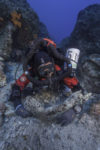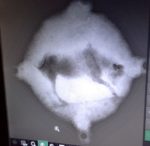The Antikythera Mechanism, the oldest analog computer in the world, was a mind-bogglingly intricate mechanism of interlocked gears which could calculate the date of eclipses, Olympic games, positions of astronomical bodies and more. Found fused in a lump that looked like a rock with some bronze flecks in it, years would pass before researchers understood that the lump was actually 87 parts of a mechanical computer corroded together. When all the pieces were puzzled together, they were found to total up to around 50% of the original device.
The mechanism was found in 1901 at the site of a 1st century B.C. shipwreck off the coast of the island of Antikythera. It didn’t stand out at the time because in the year since the wreck had been discovered, divers had collected an astonishing number and quality of marble and bronze art works, jewelry, glassware and other artifacts, likely destined for the Roman market. They ranged widely in date. The mechanism dates to the second half of the 2nd century B.C., so it could have been as much as a 100 years old when it was loaded onto the doomed ship.
Between the passage of time, the action of salt, currents, traffic, earthquakes etc., the remains of the wreck scattered and decayed. The flashiest, most obviously finds were collected in 1900-1901. In 1976, Jacques Cousteau and his crew spent two days diving the site. And that was it until 2012 when divers from the Woods Hole Oceanographic Institution and the Hellenic Ephorate of Underwater Antiquities used the latest technology to survey the wreck site.  Because of the wreck’s dangerous position 200 feet under the surface of the Aegean at the bottom of a steep slope, the Return to Antikythera project is the first scientific study of the site since it was discovered by sponge divers in 1900.
Because of the wreck’s dangerous position 200 feet under the surface of the Aegean at the bottom of a steep slope, the Return to Antikythera project is the first scientific study of the site since it was discovered by sponge divers in 1900.
The 2017 expedition picked up where the team left off in 2016, the trench where the partial human skeletal was found. Other ship gear was discovered there in 2016 — lead pipes, counterweights, tools — as well as many pottery fragments from different types of vessels.  Several significant finds were recovered the next year, including a bronze arm from a life-sized statue and a marble leg on a plinth, believed to have been part of a male nude.
Several significant finds were recovered the next year, including a bronze arm from a life-sized statue and a marble leg on a plinth, believed to have been part of a male nude.
 Among the smaller pieces and fragments was a disc thick with corrosion products and concretions. The tell-tale green of corroded metal was visible through the rock-like encrustations. The disc is about three inches in diameter and has four short protrusions at each of the corners. The object was X-rayed and holes were found in the
Among the smaller pieces and fragments was a disc thick with corrosion products and concretions. The tell-tale green of corroded metal was visible through the rock-like encrustations. The disc is about three inches in diameter and has four short protrusions at each of the corners. The object was X-rayed and holes were found in the  protrusions. The X-ray also revealed a bull engraved on the surface.
protrusions. The X-ray also revealed a bull engraved on the surface.
Further study is needed to identify it as one of the missing pieces of the Antikythera Mechanism. All we know for sure right now is that it was mounted on something, hence the little arms with pinholes, but it could have been a decorative mount for furniture, for example. If it was part of a geared mechanism, it doesn’t follow that it was THE mechanism discovered in 1901. There’s a chance there could have been a similar device on board. The ship was absolutely heaving with very high-end goods. However that is a  very slim chance indeed because nothing even remotely like the Antikythera Mechanism has been found before or since. Mechanisms of comparable complexity wouldn’t appear again until the Middle Ages.
very slim chance indeed because nothing even remotely like the Antikythera Mechanism has been found before or since. Mechanisms of comparable complexity wouldn’t appear again until the Middle Ages.
Based on the evidence so far, it looks exactly like other parts of the Mechanism, which had clearly been found incomplete. Based on the etching of the bull that can be seen with scanning, it may well be the gear that predicted the position of the zodiac constellation of Taurus.
But, secretly, we all know that once all the parts of the mechanism are once more assembled it will be enveloped in a bright and greenish glow, and we discover that it is the key to the end of mankind and the universe, to be replaced by unspeakable beasts doing unspoken things unspeakably.
The mystery of this devise is so enthralling, and an absolute fascination for me. Thank you for posting and diligently informing us of these discoveries. You are so appreciated! It leaves me wondering what may have been, but as one person astutely observed: if all scientific knowledge was deleted and destroyed, it would be re-discovered again.
“Because of the wreck’s dangerous position … at the bottom of a steep slope”
I’d have thought it would be distinctly more dangerous if it had snagged near the top of a steep slope.
BTAIM, it does make you wonder – dunnit? – about how much other advanced stuff happened in that era and later became completely forgotten about. Also: why would so much skill and ingenuity be devoted to this mechanism? Something to do with navigation? With religion? Or just appealing to intellectual delight?
YouTuber Chris is building a replica from raw metal stock. I believe that he is in Australia. The YouTube channel is “clickspring”.
As all articles ending with a question mark can be answered with a no, I almost didn’t read this. After reading this, it’s obvious that this is NOT part of the antikithera mechanism.
It is a similar material but obviously some sort of decorative piece belonging to something else.
The parts of the device that are missing is primarily the wood case it sat in.
Well, Tom, it is also possible that it is a decorative element for the case of the mechanism.